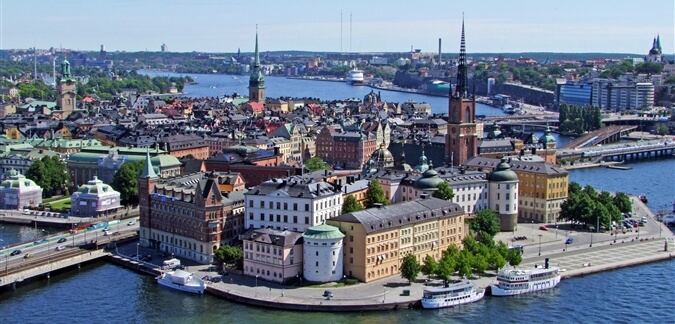
Overview:
Sweden’s capital city spreads out over 14 islands in Lake Mälaren and looks out proudly to the Baltic Sea to the east. Her grand public buildings, palaces, rich cultural history and museums tell her 700 year-old history beautifully. Nowhere is this better illustrated than in the Old Town (Gamla Stan); expect and get cobblestone streets, crooked but beautifully preserved buildings, the Royal Palace, gothic churches and excellent cafés, bars, restaurants and Swedish design-ware shops.
Holiday price from £ 655 per person based on availability and a sharing accommodation in a standard double/twin room
| SEASON |
DEPARTURES |
| All year |
Daily |
Tour Itinerary:
Day 1: Arrival in Stockholm
Upon arrival in Stockholm Arlanda Airport, take the Arlanda Express train to city centre. Trains are operated about every 15 minutes and duration of the journey is just 20 minutes. Accommodation in Stockholm at the hotel of your choice. Enjoy the rest of your day exploring the capital of Stockholm. We highly advise taking a boat tour of the city and inner archipelago.
Days 2 – 3: Exploring Stockholm & Optional Excursions
Breakfasts at the hotel followed by a free time to explore the city. Stockholm, the capital of Sweden is built on 14 islands and you are never far from water. Well-preserved medieval buildings stand alongside modern architecture, and just outside the city, the archipelago of 24 000 islands is waiting to be explored. Sights of interest include the Vasa Museum, Skansen Open Air Museum, City Hall and the Old Town (Gamla Stan). We can offer a great variety of sightseeing options in Stockholm, please ask us for details!
Day 4: Departure from Stockholm
After breakfast at your hotel, check out and take the Arlanda Express train back to the airport. Return flight.
Package Includes:
- Direct flights from London to Stockholm and return (we can arrange flights from other airports upon request)
- 1 piece of check-in luggage per traveller (up to 23 kg)
- 3 nights' accommodation in a standard double/twin room at the hotel of your choice (single supplement available)
- Breakfast daily
- Return Arlanda Airport Express train tickets
- 24 hour emergency contact
- ATOL protection
- All taxes
Enquire now »
This map uses Google Maps, so you can zoom and interact with it as we hope it is familiar to you.
For a larger version of this map which opens in a new window, click here
The lines shown give you an indication of our destinations and are not the exact route used.
You'll see...
Car Rental
You can rent a car, as long as you have a valid EU or international driver's license. Most cars will have manual transmission.
Transportation
Railway mostly serves domestic routes and is used as an easy and quick way to get from the capital to major cities of the country. There are some international routes, like to Moscow and St. Petersburg, but time spent on the way will be quite long.
Buses are one of the most convenient ways to travel between the Baltic States. Eurolines will get you between Riga, Vilnius and Tallinn. One way tickets will cost £ 15 - £ 20 and approximate travel time is 5 hours between the cities. Ticket reservations in advance are recommended.
Taxis are the quickest and most convenient way of travelling round the city. You'll find them located close to the main hotels. Usually it's quite easy to catch a taxi on the street, however, it's much better and safer to order one by phone. Taxi costs in all of the Baltic countries and Poland are approximately the same and a ride in the centre of the city will cost you approx £ 5 - £ 7. Taxis in Finland and Russia are considerably more expensive. It is always a good idea to get your hotel to book a taxi for you and ask approximately how much the trip will cost before you get in.
We would not recommend you to take public transportation within the city, as it's usually crowded and it may cause you unnecessary anxiety about where to stop.